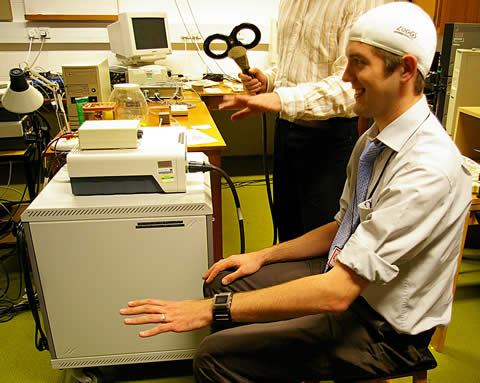Stimulating the brain with a weak electrical current can help ease depression. But it’s still not clear exactly why it works or what pattern of stimulation is best.
About 15 years ago, researchers first began using transcranial magnetic stimulation to combat depression. The treatment involves placing a specially-designed coil next to a patient’s head. When a weak electrical current is run through the coil, it induces an electrical current in the brain tissue underneath. Early reports suggested that after a few weeks of daily rounds of the regimen, some depressed patients began to feel better.
But even after a new treatment becomes generally accepted, much tinkering has to be done to work out how to get the best results. Some studies, for instance, have found that low-frequency stimulation − about 1 Hz − to regions on the brain’s right side worked well. Others found that adding to that some high frequency stimulation − about 10 Hz − on the left side was effective. There were also reasons to think that low frequency stimulation to both brain hemispheres might work.
Jeff Daskalakis, who heads the Brain Stimulation Treatment and Research Unit at the Centre for Addiction and Mental Health and is a U of T professor of psychiatry, wanted to compare these paradigms head to head. He and his colleagues studied 219 patients suffering from treatment-resistant depression and randomly assigned them to one of the three treatment groups.
The researchers’ hypothesis was that bilateral stimulation would work better than unilateral. After four weeks of daily treatments, over 50 per cent of all the patients had shown improvement. But not only was there was no advantage of bilateral over unilateral treatment, there were hints that unilateral was in fact better. They published their results in the latest issue of Psychological Medicine.
The antidepressant effects of transcranial magnetic stimulation may not have much to do with frequency or laterality, they concede in the paper. It could be that repetitively stimulating the front part of the brain at any frequency somehow strengthens connections, leading to a healthier brain function and, in turn, an improved mood.
Recent Posts
U of T’s 197th Birthday Quiz
Test your knowledge of all things U of T in honour of the university’s 197th anniversary on March 15!
Are Cold Plunges Good for You?
Research suggests they are, in three ways
Work Has Changed. So Have the Qualities of Good Leadership
Rapid shifts in everything from technology to employee expectations are pressuring leaders to constantly adapt






